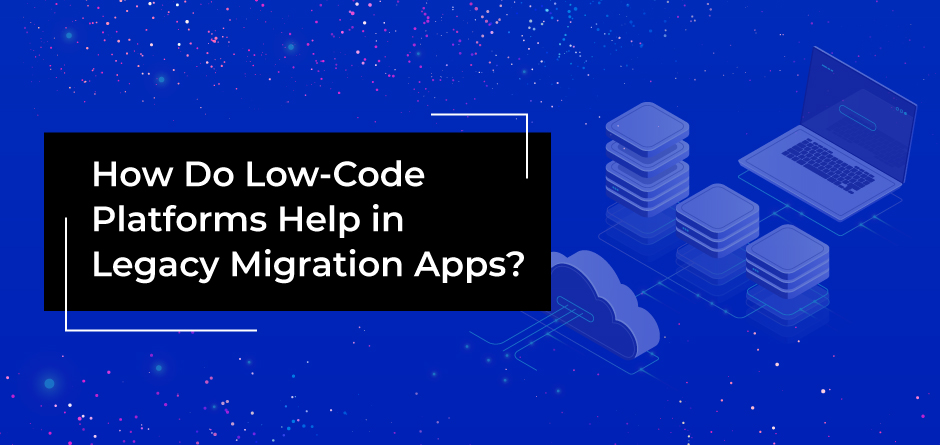
How Do Low-Code Platforms Help in Legacy Migration Apps?
The technology, application, or any other systems which we have been using for the last 20-30 years, cannot be compared with the integrated and improved systems that we are using now. The system or methods of those times can be termed as ‘Legacy Systems’. Simply, legacy systems are outdated technologies.
No matter how important and revolutionary that system proved to be in those old times, it cannot stand strong in the present, with a multitude of technologies providing better service with many flexibilities. Technologies and ideas are changing our lives in such a way that it’s impossible to rely on old systems.
So, one can state that legacy systems are holding businesses back. At the same time, we have to acknowledge that without those legacy systems, we could not have come along so far. And the fact remains that we are still using that in the present.
So in such a situation, what are we supposed to do? What could prove to be a good solution to overcome these obstacles? Undoubtedly, we have to integrate those legacy systems to the latest ones.
In the digitally transformed era, one has to come to terms with the fact that if they genuinely want to grow their organization or businesses, they have to migrate from the legacy and have to embrace the new, digitally changed environment. Every organization, sooner or later, will have to consider the new legacy modernization and migration strategy.
Legacy Migration Challenges (and the Low-Code Solutions)
It’s the lack of flexibility in the system that leads to a legacy for tomorrow.
Challenges:
- The system is simply working fine and that is why organizations see no advantage of migrating it.
- Migrating the software is simply not that cost-effective.
- The developer of that particular app has ended the contract and the other developer does not know much about the app and hence faces difficulty in migrating.
- No proper documentation is available to understand the software, so migrating the app becomes a hard nut to crack.
Why are We Migrating the Legacy Systems?
- Maintenance
The maintainability of the software consumes too much time, especially when the developer has left the organization and others have no clue about the code that has already been written. Also, the newcomer has to spend a huge amount of time to understand the codes and will need the training to compile the outdated software.
- Hard to break the monoliths
The software is built of many small components, and failure of one tiny part of the software, even if it is not connected or related to another component can lead to the failure of the entire software. Also, if one small part is changed then it will affect the entire application and no one wants to invest a huge amount for the failure of any tiny part.
- Security Vulnerabilities of the Legacy Systems
This year’s study reports the global average cost of a data breach is up 6.4 percent over the previous year to $3.86 million. The average cost for each lost or stolen record containing sensitive and confidential information also increased by 4.8 percent year over year to $148.
-IBM, The Cost of a Data Breach Study
Solution: Migrating the Legacy System to Low-Code
Low-code is built for its easy adaptability to future changes and integrations. Now is the time for every IT organization to embrace a low-code platform because it is the fastest way to develop any app and make changes quite easily to the developed software.
For the IT industries, all that matters is time, and low-code is an extraordinarily time-effective platform to develop the application. Moreover, low-code needs no programming skills to develop the app and anybody can easily make the app without having any extra technical knowledge.
Low-code preserves the functionality of the legacy software and of course, the owner or the stakeholder of the app wants to have all the functionalities to be preserved.
Low-code is a visual representation of the app. It is based on the “what you see is what you get” (WYSIWYG) facility, meaning you can see your application while developing it.
A low-code application development platform is an easy way to build software applications faster by reducing the need to write Lines of lengthy code. Low-code applications are built using a visual development environment with tools like drag and drop modelers/widgets, smart services, components, and pre-built connectors.
The drag and drop approach uses templates and boilerplate code to help users develop software quickly. Those who need a more customized solution might still need to use traditional high-code platforms. Gartner predicts that the low-code technology market will grow 23% globally in 2021.
Mendix :
Mendix is a low-code platform on which you can develop your application with all the ease you wish to have in a low-code platform.
“Using the Mendix platform, we can do things we simply wouldn’t have been able to do using traditional development methods because Mendix is so much faster and easier. The platform has allowed our IT department to become an enabler and change agent within the organization.”
– Wade Sendall, Vice President of IT, The Boston Globe
RECENT POSTS
CATEGORIES
